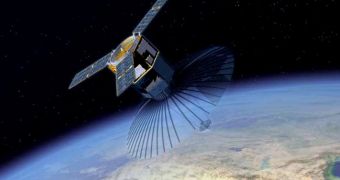Officials at the West Falls Church, Virginia-based Northrop Grumman Corporation, announce that their Modular Space Vehicle (MSV) project managed to pass its preliminary design review (PDR) test with flying colors. This allows the company to start focusing on further developing the spacecraft.
At this point, the Northrop team is planning on how to move ahead towards a critical design review, and then on to manufacturing. The space vehicle is being developed for the US Department of Defense.
The DoD manages the project through its Operationally Responsive Space (ORS) Office, which is based at the Kirtland Air Force Base (KAFB), in New Mexico. The Office tasked the NASA Ames Research Center (ARC), in Moffett Field, California, with handling the Northrop spacecraft.
One of the most important conditions the ARC team imposed on Northrop was the successful completion of the PDR. This now counts as reaching an important MSV program milestone.
Together with ATA and DesignNet Engineering, the Virginia-based corporation is developing the MSV as a rapid response space asset, capable of supporting commanders in the field at a moment's notice.
“Successful completion of the PDR is a significant milestone validating our design and confirming the Northrop Grumman-led team's proven capabilities and commitment to delivering an innovative and affordable MSV, on schedule and on budget,” expert Steve Hixson explains.
The representative holds an appointment as the vice president of Advanced Concepts – Space and Directed Energy Systems at Northrop's Aerospace Systems division. He explains that the PDR provides both the company and its partners with the ability to evaluate ongoing progress and make further decisions.
“We are proud of the team's progress since the program kick off last December and we are clearly focused on supporting the ORS program office vision to provide innovative operationally responsive space assets to support the Joint Force,” Hixson says.
One of the most important points the PDR touched on was the manner in which the entire space system Northrop proposes is compatible with the required performance, technical requirements and system specifications.
This is critically-important for a mission such MSV, where flexibility and cross-compatibility are extremely important. The space vehicle itself will be modular, meaning that it will use avionics architecture technologies that need to work in any configuration.
The main goal in doing so is to reduce the amounts of time currently needed to manufacture, integrate, test and launch space vehicles.
“The approach and technology we're using provides a low cost reconfigurable spacecraft bus that supports the ORS vision of a multimission modular bus and opens new markets to additional customers,” Ricj Hayner explains.
“Based on the success of this PDR we are moving forward with detailed design and progressing toward a critical design review planned for the first quarter of 2012,” adds the official, who is the MSV program manager at Northrop.

 14 DAY TRIAL //
14 DAY TRIAL //